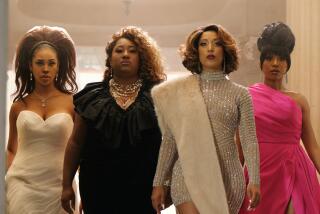KCET: VIEWERS NOT UPSET OVER NEW SPONSOR SPOTS
- Share via
The record contributions generated by KCET during its recent on-air fund-raising drive bore special significance for executives at the public-television station.
They took the results as the clearest sign yet that Channel 28’s quiet effort to slip a small dose of advertising into its schedule has not alienated viewers.
For the last 10 months, KCET has been peppering its lineup with low-key “messages” from program underwriters--10-, 15- and 30-second spots that plug the sponsoring company and sometimes one of its products.
In addition to appearing immediately before and after a program that has received a corporate grant--the places traditionally reserved for identification of public television underwriters--these spots are occasionally popping up unconnected to any particular broadcast.
What followed a recent telecast of “The Wild, Wild World of Animals,” for example, were three promotional spots for upcoming wildlife documentaries, then the voice of an announcer who offered thanks for the support shown to KCET by subscribers and “the following” company--after which a paid ad for Marineland appeared. The spot showed viewers what they could experience at the aquatic park, but stopped short of asking them to visit.
Although fraught with potential danger from a public-relations standpoint, this move toward commercialization of the non-commercial station has produced “practically no reaction,” said William Kobin, Channel 28 president.
Besides the complaint-free August pledge drive, Kobin said that he has received only a few letters and comments about the new type of underwriter spots--and some were positive.
“Our experience suggests that what we are doing has certainly, up to this point, been accepted,” said Timothy Conroy, the station’s vice president of development.
KCET is doing what many public-television stations across the country are doing: trying to bolster revenues by attracting more companies to make donations with the lure of expanded on-air credit for their support.
Conceding that permitting even this limited form of advertising on public television is philosophically distasteful, Kobin emphasized that, in the wake of cutbacks in the federal appropriation to public broadcasting over the past several years, he believes that from a practical standpoint it is “essential to the maintenance of the quality of this system.”
And he vowed that the quality of programming will not be impaired by the “enhanced underwriting credits.”
In the past, corporations providing financial support to a particular program could only be identified on the air by having their name appear in block letters before and after the show. But in March, 1984, the FCC relaxed its rules on underwriter crediting, as recommended by a congressional study of alternative financing proposals for public broadcasting.
The easing of restraints was intended to help stations in two ways: by attracting companies that avoided the medium because they didn’t believe they were getting enough public credit for their support, and attracting smaller companies that couldn’t afford to underwrite an entire series or special but now can get credit between programs for general support.
It’s hard to tell what the financial effect of enhanced underwriting might be, said Lance Ozier, vice president of program administration for the Public Broadcasting Service. “It seems to have a lot of potential for a market like Los Angeles. But once you get past the top 20 or 25 markets, it’s relatively unclear what potential it has.”
FCC guidelines restrict the nature of the advertising that public-television stations can accept. The enhanced underwriting spots cannot interrupt programs and they cannot use hard-sell techniques--no hyperbole about the virtues of a product, no comparisons with other products, no solicitations to use the product.
The first such spot that KCET ran in December was typical: It was a “season’s greetings” spot from Wells Fargo. Another spot, purchased by Honda, was primarily a safety reminder to motorists to buckle their seat belts. An animated spot from Mitsubishi simply noted that the company makes television sets.
Some of these spots have aired on commercial television; others have been adapted from commercial-TV ads. Ultimately, Channel 28 officials said they hope spots will be produced specifically for public TV.
In the meantime, Kobin said, KCET’s four-man review panel--consisting of him, Conroy, Stephen Kulczycki, programming vice president, and Donald Youpa, marketing vice president--is rejecting about 80% of the spots submitted for consideration because they don’t meet the station’s standards.
Conroy said that KCET is airing about four or five underwriting spots a week, which bring in about $1,600 to $4,000 each, depending on the time they are aired. The station hopes to increase the frequency, he said, but no specific goals have been set.
Although encouraged by results, Kobin stressed that KCET is still in the learning stages with enhanced underwriting and remains cautious about how far to go with it.
“We are feeling our way very, very slowly,” he said. Noting that two-thirds of the station’s support comes from viewer contributions, he said, “We don’t want to jeopardize such support; it’s critical that we don’t jeopardize it.”
Kobin said that neither he nor anyone else in public broadcasting looks on enhanced underwriting as a substitute for viewer subscriptions or federal funding. He declined to specify how much money the station expects to reap from it this year, but he said he doesn’t envision it becoming a multimillion-dollar source of revenue for KCET.
Kobin and Conroy were adamant in asserting that the introduction of expanded underwriting has not and will not change the nature of the programming KCET offers.
While some critics--including some inside public broadcasting--have warned that sponsors will always push to reach the greatest number of viewers, the Channel 28 executives said that the ones they’ve dealt with have expressed the opposite notion.
“They don’t want us to change the nature or the quality of our program schedule,” Kobin said. “Their objective is the enhancement of the company by associating it with a quality television program.”
To change, Conroy said, would be to “fly in the face of what the marketplace is telling us they want. . . . We are trying to position ourselves as the premier, most attractive TV environment available.”
More to Read
The complete guide to home viewing
Get Screen Gab for everything about the TV shows and streaming movies everyone’s talking about.
You may occasionally receive promotional content from the Los Angeles Times.






